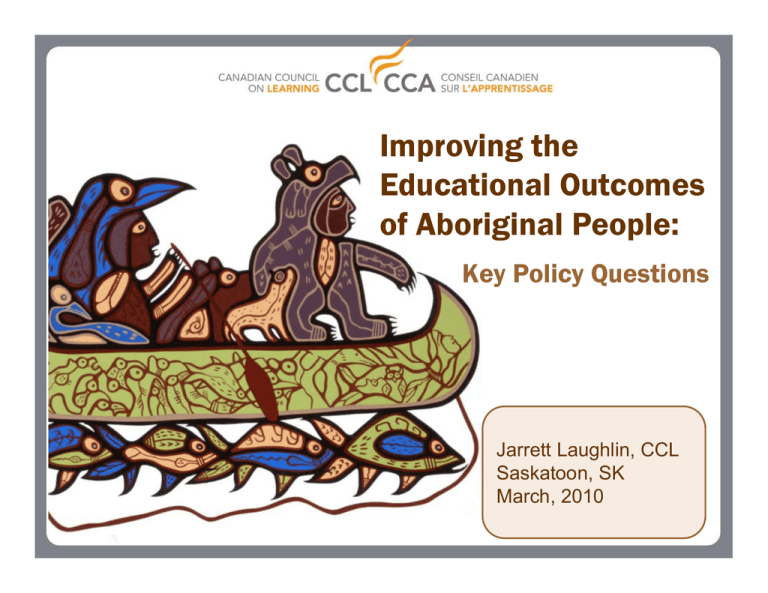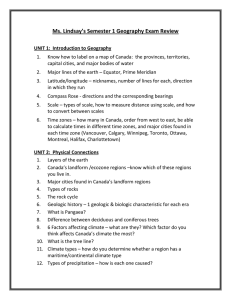Improving the Educational Outcomes of Aboriginal People: Key Policy Questions
advertisement

Improving the Educational Outcomes of Aboriginal People: Key Policy Questions Jarrett Laughlin, CCL Saskatoon, SK March, 2010 Aboriginal Learning: What do we know? High aspirations for learning Poor learning outcomes 80% of Aboriginal youth aspire for post-secondary 40% of Aboriginal youth complete post-secondary 60% of Aboriginal youth complete high-school 2 Aboriginal Learning: Why is this? High aspirations for learning Poor learning outcomes Factors contributing to success • • • • Effective teachers Engaged parents Relevant curriculum Language and culture • • • • Role models Socio-economic factors Mobility … 3 Aboriginal Learning: Why so little improvement? High aspirations for learning Factors contributing to success Solutions Aboriginal Perspectives on Learning Poor learning outcomes Conventional Approaches to Measurement 4 1. Redefining Success in Aboriginal Learning “Current approaches to measuring First Nations, Inuit and Métis learning need to be broadened to reflect Aboriginal people’s articulation of holistic, lifelong learning.” January 2007 5 1. Redefining Success in Aboriginal Learning What is Aboriginal Learning? • Holistic; • Lifelong; • Spiritually oriented; • Community activity; • Rooted in Aboriginal languages and cultures; February 2007 • Integrates Aboriginal and Western knowledge; 6 1. Redefining Success in Aboriginal Learning Community Workshops • Brought together Aboriginal learning professionals, researchers and governments from more than 50 organizations across Canada. May/June 2007 7 1. Redefining Success in Aboriginal Learning 8 2. New Measurement Approaches Needed Limitations of current approaches • Do not monitor the full spectrum of lifelong learning; • Do not reflect holistic nature of Aboriginal learning; • Do not reflect importance of experiential learning. • Do not account for social, economic and political realities; November 2007 • Orientated toward measuring learning deficits; 9 2. New Measurement Approaches Needed Limitations of current approaches Aboriginal Perspectives on Learning Conventional Approaches to Measurement November 2007 10 “Indicators run the risk of becoming either irrelevant for communities or unable to inform effective government policy.” - CCL, Redefining How Success is Measured 2007 11 Holistic Learning Measurement Framework New Framework • Holistic Lifelong Learning Measurement Framework incorporates common elements, while integrating unique learning perspectives of each model. December 2009 12 Holistic Learning Measurement Framework Community Well-Being Domain 13 Holistic Learning Measurement Framework 14 Holistic Learning Measurement Framework • The new framework highlights new information about Aboriginal learning. • The information needed to develop new solutions. • Provides a more complete picture of the state of Aboriginal learning in Canada. December 2009 15 2009: State of Aboriginal Learning in Canada Key Findings • Reading to children Sources: Statistics Canada, 2000-01 National Longitudinal Survey of Children and youth Statistics Canada, 2001 Aboriginal Children’s Survey 16 2009: State of Aboriginal Learning in Canada Key Findings • Early childhood education Source: Statistics Canada, 2006 Aboriginal Children’s Survey 17 2009: State of Aboriginal Learning in Canada Key Findings • Traditions and ceremonies Source: Statistics Canada, 2006 Aboriginal Children’s Survey 18 2009: State of Aboriginal Learning in Canada Key Findings • Incomplete high-school Source: Statistics Canada, 2006 Census 19 2009: State of Aboriginal Learning in Canada Key Findings • Learning from the community Source: Statistics Canada, 2001 & 2006 Aboriginal Peoples Survey 20 2009: State of Aboriginal Learning in Canada Key Findings • Exposure to Elders Source: Statistics Canada, 2006 Aboriginal Peoples Survey 21 2009: State of Aboriginal Learning in Canada Key Findings • Learning in the community Source: Statistics Canada, 2006 Aboriginal Peoples Survey 22 2009: State of Aboriginal Learning in Canada Key Findings • Youth volunteerism Source: Statistics Canada, 2006 Aboriginal Peoples Survey 23 2009: State of Aboriginal Learning in Canada Key Findings • Use of Aboriginal language in the home Source: Statistics Canada, 2001 & 2006 Census 24 2009: State of Aboriginal Learning in Canada Key Findings • Traditional skills Source: Statistics Canada, 2006 Aboriginal Peoples Survey 25 2009: State of Aboriginal Learning in Canada Key Findings • Equal footing on college and trades attainment. • Wide gap in university attainment. Source: Statistics Canada, 2006 Census 26 2009: State of Aboriginal Learning in Canada Non-Learning Factors • Many Aboriginal youth have a parent who was in residential school. Source: Statistics Canada, Aboriginal Peoples Survey 27 2009: State of Aboriginal Learning in Canada Non-Learning Factors • Aboriginal youth are twice as likely to live with a single parent. Source: Statistics Canada, 2006 Census 28 2009: State of Aboriginal Learning in Canada Non-Learning Factors • The bottom 100 communities were First Nations communities. Source: Indian and Northern Affairs Canada (unpublished) 29 “We have constantly measured the wrong things against a different paradigm— leading inevitably to an assessment of ‘failure’.” - Participant, CCL workshop, February 2008 30 Concluding Remarks • A more complete picture leads to more informed solutions. • Can move away from current policy and program development that reacts to learning deficits. • Can shift to solutions that recognize, build upon and celebrate strengths. • Identify solutions that focus on nonlearning factors in the community and home, in order to address the challenges in the classroom. 31 Contact information Canadian Council on Learning Jarrett Laughlin Senior Research Analyst jlaughlin@ccl-cca.ca Facebook site (Aboriginal Learning in Canada – CCL). Discussion form to share uses of Holistic Lifelong Learning Models 32







